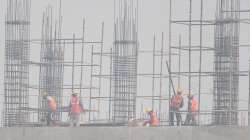Delhi's air quality 'poor', no significant change likely
Delhi's air quality deteriorated marginally and was recorded in the "poor" category on Wednesday as a change in the wind direction increased the share of stubble burning in the city's pollution slightly.

Delhi's air quality deteriorated marginally and was recorded in the "poor" category on Wednesday as a change in the wind direction increased the share of stubble burning in the city's pollution slightly. The city's air quality index (AQI) was recorded in the "moderate" category in the morning. However, pollution levels increased by a bit as the day progressed. The 24-hour average AQI stood at 211. It was 171 on Tuesday.
An AQI between zero and 50 is considered "good", 51 and 100 "satisfactory", 101 and 200 "moderate", 201 and 300 "poor", 301 and 400 "very poor", and 401 and 500 "severe".
Weather experts and government agencies said no significant change was likely in the next three to four days.
V K Soni, the head of the India Meteorological Department's environment research centre, said northwesterly winds increased the stubble burning contribution slightly on Wednesday.
According to the Ministry of Earth Sciences' air quality monitor, SAFAR, stubble burning accounted for eight per cent of Delhi's PM2.5 pollution on Wednesday. It was three per cent on Tuesday.
Around 800 fire points were observed in Punjab, Haryana and western Pakistan. However, their impact on Delhi-NCR's air quality will not be significant, Soni said.
The AQI is again going to improve to the "moderate" category by Friday owing to favourable wind speed, he said.
The central government's Air Quality Early Warning System for Delhi also said Delhi-NCR's air quality is likely to remain in the "moderate" and the lower-end of the "poor" category on Thursday and Friday.
On Wednesday, the prominent surface wind direction was northwesterly and the maximum wind speed 10 kmph, it said.
The minimum and maximum temperatures settled at 10.6 degrees Celsius and 25.4 degrees Celsius respectively.
Delhi's ventilation index – a product of mixing depth and average wind speed – was around 5,000 square metre per second on Wednesday and is likely to be 7,500 square metre per second on Thursday.
Mixing depth is the vertical height in which pollutants are suspended in the air. It reduces on cold days with calm wind speed.
A ventilation index lower than 6,000 square metre per second, with the average wind speed less than 10 kmph, is unfavourable for dispersal of pollutants.
The IMD said the minimum temperature in Delhi is predicted to drop to 9 degrees Celsius by Saturday, as cold winds have started blowing from hilly regions, which have witnessed a fresh bout of snowfall.
The minimum temperature this month, barring on November 16, has remained 2-3 degrees below normal in the absence of a cloud cover, according to IMD officials.